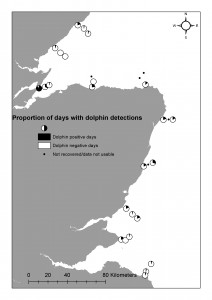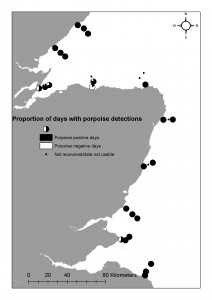Marine
World Leading Mammal Acoustic Monitoring Programme in its second year
August 18, 2014 by Marine Scotland Communications No Comments | Category Marine Directorate Science
 Marine Scotland is currently running a world leading monitoring programme to detect the presence of dolphins and porpoises at 30 sites along the east coast of Scotland. The aim of the programme is to establish the distribution of dolphins and porpoises, providing valuable information on which to base future marine renewable developments.
Marine Scotland is currently running a world leading monitoring programme to detect the presence of dolphins and porpoises at 30 sites along the east coast of Scotland. The aim of the programme is to establish the distribution of dolphins and porpoises, providing valuable information on which to base future marine renewable developments.
In May 2014, work began on the second annual deployment of moored CPODs (echolocation click detectors), which detect the presence of dolphins and porpoises. These are clustered in sets of three at increasing distance from shore, at 10 locations around the coast. One mooring out each group of three also holds a broadband acoustic logger, which records ambient noise levels, as well as dolphin whistles. Analysis of whistles allows identification of dolphins to species level.
Last year, porpoises were detected at most sites every day, and at the Fraserburgh site, porpoises were detected for an average of 19 hours. However, the known aggressive interactions between dolphins and porpoises mean that porpoises were not detected as often in areas that bottlenose dolphins are known to visit.
The data will allow assessments to be made about whether planned wind farm developments may affect the broad scale distribution of dolphins and porpoises across the east coast and the ambient noise measurements will also be used to inform Marine Strategy Framework Directive (MSFD) noise descriptors. The noise measurements are also being analysed by the National Physical Laboratory as part of a project developing underwater soundscapes.
(Attached maps compiled using data from moored CPODs)



Leave a comment